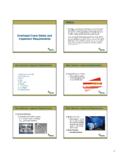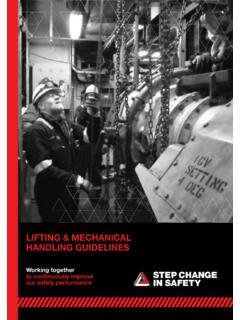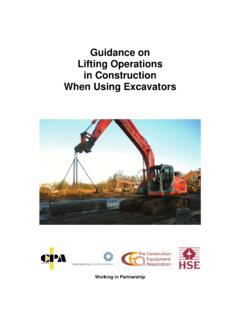Transcription of Lifting equipment at work - HSE
1 Health and Safety ExecutiveLifting equipment at workA brief guide1 of 11 pagesINDG474 Published 2017 Introduction This leaflet is mainly for dutyholders (employers, the self-employed and people who have some level of control over Lifting equipment ). It provides advice on the Lifting Operations and Lifting equipment Regulations 1998 (LOLER) which deal with the specific risks associated with the use of Lifting equipment . It describes what you should do to protect yourself, your employees and others in the workplace. It will also be useful to employees and their representatives. LOLER covers work equipment in workplaces where the Health and Safety at Work etc Act 1974 (the HSW Act) applies, this includes factories, offshore installations, agricultural premises, construction sites, offices, shops, hospitals, hotels, places of entertainment a dutyholder you should refer to the regulations and Approved Code of Practice to familiarise yourself fully with your duties (see Safe use of Lifting equipment1).
2 This leaflet supplements Providing and using work equipment safely (INDG291),2 which deals with the general duties relating to work equipment required by the Provision and Use of Work equipment Regulations 1998 (PUWER). What equipment is covered by LOLER? There are two important definitions you need to know: Lifting equipment means equipment used at work for Lifting or lowering loads. The definition includes attachments used to anchor, fix or support the equipment (eg the runway for an overhead crane). Accessory for Lifting means Lifting equipment for attaching loads to machinery for scope of LOLER is very wide and covers a range of work equipment , including: cranes; industrial lift trucks; telehandlers; passenger lifts; hoists; mobile elevating work platforms; scissors lifts; vehicle lifts; vehicle tail lifts; dumb waiters; bath and Safety Executive2 of 11 pagesLifting equipment at work: A brief guideIt also includes Lifting accessories such as: slings; hooks; shackles; eyebolts; clamps and grabs; magnets; vacuum lifters; crane forks; Lifting beams; spreaders etc.
3 If you allow employees to provide their own Lifting equipment , this too is covered and should comply with LOLER. What equipment is not covered by LOLER? Some equipment used in Lifting is not covered by LOLER, for example equipment whose principal function is not Lifting , such as conveyor belts, or the three-point linkage on a tractor. Where this is the case, you would still have duties under PUWER to ensure the work equipment is safe and suitable. LOLER does not apply if you provide equipment to be used primarily by members of the public, such as passenger lifts in shopping centres or train stations. However, you still have duties under the HSW Act to ensure the equipment is safe. Following the requirements in LOLER will help you meet those does not apply to escalators, which are covered more specifically by the Workplace (Health, Safety and Welfare) Regulations 1992.
4 Items such as pallets, skips, ladles, one-trip integral slings attached to a load and similar containers are considered part of the load. They are not subject to the requirements relating to Lifting equipment and accessories for Lifting . However, LOLER does require every part of a load and anything attached to it and used in Lifting to be of adequate strength. What does LOLER require me to do? You need to make sure that when using any Lifting equipment the requirements of LOLER are met. For example, you should make sure that all Lifting equipment is: sufficiently strong, stable and suitable for the proposed use. Similarly, the load and anything attached (eg timber pallets, Lifting points) must be suitable; positioned or installed to prevent the risk of injury, eg from the equipment or the load falling or striking people; visibly marked with any appropriate information to be taken into account for its safe use, eg safe working loads.
5 Accessories, eg slings, clamps etc, should be similarly marked. Additionally, you must make sure that: Lifting operations are planned, supervised and carried out in a safe manner by people who are competent; where equipment is used for Lifting people it is marked accordingly, and it should be safe for such a purpose, eg all necessary precautions have been taken to eliminate or reduce any risk; Health and Safety Executive3 of 11 pagesLifting equipment at work: A brief guide where and when appropriate, Lifting equipment (including accessories) is thoroughly examined by a competent person and appropriate action taken regarding subsequent examination/inspection reports (see Thorough examination section for details).
6 What can go wrong?Using Lifting equipment can present a number of hazards: people can be hit and injured by: moving parts; dropped loads; unplanned or unintended movement or release of loads; people can be crushed both between moving loads and parts of the machine, walls or other objects; parts of the body can be drawn in or trapped between rollers, belts, chains and pulley drives; Lifting equipment or accessories for Lifting can become unreliable and develop faults due to poor maintenance, or machines may be used improperly through inexperience or lack of training; parts of the equipment may fail and loads may drop. Safe Lifting by machine If you are an employer or a self-employed person providing Lifting equipment for use at work, or if you have control of the use of Lifting equipment , you must make sure that the work is carried out safely and the right equipment for the task is used.
7 Think about what risks there may be and how they can be managed. For example: damage or deterioration of the equipment or attachments caused by wet, abrasive or corrosive environments; equipment failure; untrained workers planning the lift or using the equipment ; trying to move loads that exceed the load limit of the machine; uncontrolled movement of the load or the Lifting needs to be properly planned by a competent person, appropriately supervised and carried out safely taking into account the environment and operating conditions. Any equipment you use must have been properly designed, manufactured and tested. Don t forget maintenance. Factors you should consider What are you Lifting and what problems does it present?
8 How heavy is it and is this within the safe limits for the Lifting equipment and accessories? Where is its centre of gravity? How will you attach it to the Lifting machinery? Who is in control of the lift? Could you rehearse the lift if necessary? Are there any additional risks, eg from high winds or other weather conditions? The route of the lift will the load be lifted over an occupied area?Health and Safety Executive4 of 11 pagesLifting equipment at work: A brief guideDos and don ts of Lifting safelyDo Use equipment that is marked with its safe working load, which is not overdue for examination, or is new with an EC Declaration of Conformity less than one year old, and was not assembled on site for this lift.
9 Plan the Lifting work, identifying the equipment , people and method of Lifting . Make sure the load is properly attached to the Lifting equipment . If necessary, securely bind the load to prevent it slipping or falling off. Before Lifting an unbalanced load, find out its centre of gravity. Raise it a few inches off the ground and pause there will be little harm if it drops. Use packing to prevent sharp edges of the load from damaging slings and do not allow equipment to be damaged by being dropped, dragged from under loads or subjected to sudden loads. When using jib cranes, make sure any indicators for safe loads are working properly and set correctly for the job and the way the machine is configured. Use outriggers where necessary.
10 When using multi-leg slings make sure the sling angle is taken into account. Have a responsible slinger or banksman and use a recognised signalling system. Check weather conditions where the lift could be affected. Keep the reports of thorough examination as well as any declarations of conformity or test certificates (see Thorough examination section).Don t Use unsuitable equipment , eg makeshift, damaged, badly worn chains shortened with knots, kinked or twisted wire ropes, frayed or rotted fibre ropes. Exceed the safe working load of machinery or accessories like chains, slings and grabs. Remember that the load in the legs of a sling increases as the angle between the legs increases. Lift a load if you doubt its weight or the adequacy of the maintenance Why is maintenance of equipment important?















